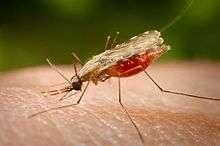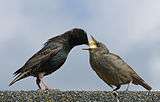Anautogeny
In entomology, anautogeny is a reproductive strategy in which an adult female insect must eat a particular sort of meal (generally vertebrate blood) before laying eggs in order for her eggs to mature.[1] This behavior is most common among dipteran insects, such as mosquitoes.[2] Anautogenous animals often serve as vectors for infectious disease in their hosts because of their contact with hosts' blood. The opposite trait (needing no special food as an adult to successfully reproduce) is known as autogeny.[3]

Factors governing anautogeny
Anautogenous insects generally reach adulthood without sufficient reserves of nutrients (particularly protein) to produce viable eggs, necessitating additional feeding as adults. A high-protein meal, usually of blood, allows the production of yolk to nourish the eggs and makes reproduction possible.[4] This blood is typically obtained through ectoparasitism on large vertebrates.
However, even individuals who do have the reserves needed to produce viable eggs may still be unable to reproduce without a blood meal, because egg maturation in many anautogenous species depends upon hormones that are released when blood is consumed.[5] Further, females with certain genotypes are anautogenous by default but can be triggered to reproduce autogenously by mating with a male, possibly because of hormones released or acquired during mating or possibly because of some nutritional supplement the mating provides.[6]
Individuals of the same species can be found to exhibit autogeny or anautogeny depending on their genotypes as well as on environmental circumstances and the type and amount of nourishment they obtained in their larval stage.[3][7] Mathematical models have indicated that anautogeny can be an advantageous strategy for insect reproduction under favorable conditions (particularly when hosts are easy to find, when the insects have a good chance of surviving the blood-feeding, and when anautogeny contributes to increased fecundity).[8]
Anatomy and physiology
Anautogeny and consequent blood-feeding is seen mainly among the dipteran insects, including mosquitoes, black flies, sand flies, horse flies, and biting midges. Most anautogenous dipterans possess sharp, blade-like mandibles for extracting blood, though these mouthparts are often underdeveloped in the male.[2] Since these species get additional nourishment from other fluid foods such as nectar or fruit juices, they exhibit a "dual sense of hunger" by which they regulate their intake of sugary foods and proteinaceous foods separately.[6]
In insects (as in other non-mammalian animals), egg maturation begins with vitellogenesis, the deposition of yolk proteins triggered by the release of juvenile hormones. In anautogenous mosquitoes, yolk production genes are strongly activated after a blood meal through a process involving the target of rapamycin signal pathway.[9] In particular, certain amino acids found in the blood proteins seem to be necessary for the activation of the vitellogenin gene.[10]
Autogeny
The need to feed on blood before laying eggs is less remarkable in animals whose ordinary diets consist largely or entirely of blood, such as ticks; in these taxa it is autogeny, or the ability to lay eggs without a blood meal, that is more remarked upon.[11] Many insects are able to produce eggs without ingesting proteinaceous food as adults, relying upon stores of nutrients they acquired as larvae. Most, however, can lay relatively few eggs without feeding on protein, and almost all require a high-protein meal to lay additional eggs after a first batch.[3]
See also
References
- "Anautogenous". Merriam-Webster Medical Dictionary. Retrieved 25 June 2016.
- "Dipteran". Encyclopædia Britannica. Retrieved 25 June 2016.
- Engelmann, Franz (2015). The Physiology of Insect Reproduction (revised ed.). Elsevier. pp. 124–7. ISBN 9781483186535. Retrieved 25 June 2016.
- Attardo, Geoffrey M; Hansen, Immo A; Raikhel, Alexander S (July 2005). "Nutritional regulation of vitellogenesis in mosquitoes: implications for anautogeny". Insect Biochemistry and Molecular Biology. 35 (7): 661–75. doi:10.1016/j.ibmb.2005.02.013. PMID 15894184.
- Gulia-Nuss, M; Elliot, A; Brown, MR; Strand, MR (November 2015). "Multiple factors contribute to anautogenous reproduction by the mosquito Aedes aegypti". Journal of Insect Physiology. 82: 8–16. doi:10.1016/j.jinsphys.2015.08.001. PMC 4630150. PMID 26255841.
- Lehane, Michael (2012). Biology of Blood-Sucking Insects. Springer Science & Business Media. pp. 107–8. ISBN 9789401179539. Retrieved 25 June 2016.
- Flatt, Thomas; Heyland, Andreas (2011). Mechanisms of Life History Evolution. Oxford University Press. p. 130. ISBN 9780199568765. Retrieved 25 June 2016.
- Tsuji, N; Okazawa, T; Yamamura, N (July 1990). "Autogenous and anautogenous mosquitoes: a mathematical analysis of reproductive strategies". Journal of Medical Entomology. 27 (4): 446–53. doi:10.1093/jmedent/27.4.446. PMID 1974928.
- Hansen, Immo A; Attardo, Geoffrey M; Park, Jong-Hwa; Peng, Quan; Raikhel, Alexander S (July 2004). "Target of rapamycin-mediated amino acid signaling in mosquito anautogeny". Proceedings of the National Academy of Sciences of the United States of America. 101 (29): 10626–31. doi:10.1073/pnas.0403460101. PMC 489984. PMID 15229322. Retrieved 25 June 2016.
- Attardo, Geoffrey M; Hansen, Immo A; Shiao, SH; Raikhel, Alexander S (August 2006). "Identification of two cationic amino acid transporters required for nutritional signaling during mosquito reproduction". The Journal of Experimental Biology. 209 (16): 3071–8. doi:10.1242/jeb.02349. PMID 16888056.
- Feldman-Muhsam, B (June 1973). "Autogeny in Soft Ticks of the Genus Ornithodoros". Journal of Parasitology. 59 (3): 536–539. doi:10.2307/3278790. JSTOR 3278790.
